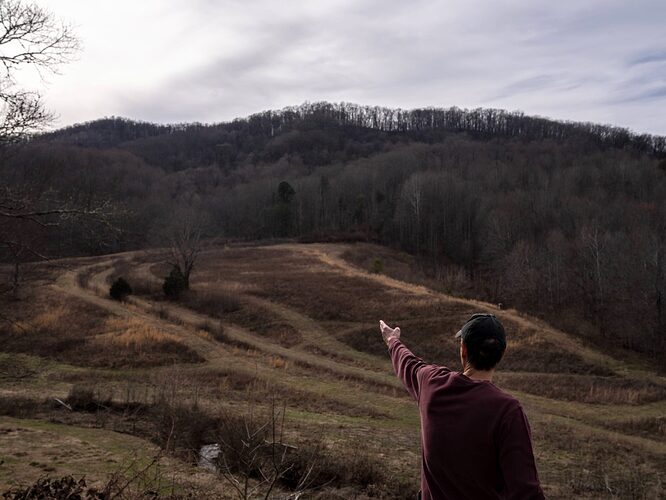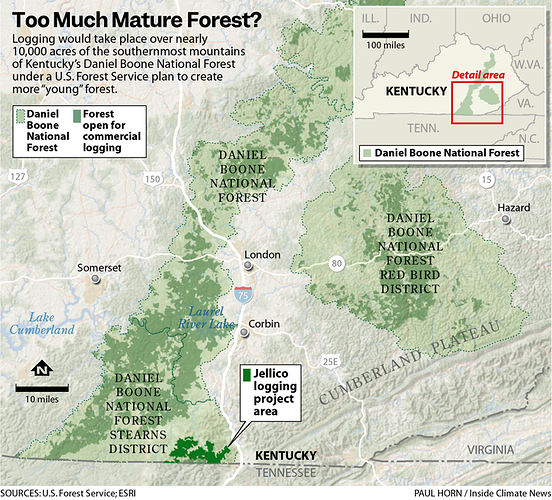WILLIAMSBURG, Kentucky—Brandon Bowlin learned of the U.S. government’s plan for clear-cutting in the southernmost mountains of Daniel Boone National Forest only a few weeks after the hard summer rains of 2022, when the earth slid off a mountain beneath a slope he had once logged.
Since age 14—when Bowlin first held a chainsaw—he has harvested timber in these woods. But they’ve also been his hunting grounds and refuge. It’s a place where he has come across oaks so wide that three men couldn’t join hands around the trunk, trees that witnessed history before the United States existed and could live well into the future.
Bowlin, 37, and his wife, Charity, bought a home nestled beside this forest last year, hoping the land and lush mountains would be a legacy for their teenage children. Now, they could inherit a front row seat to one of the largest and longest-term logging projects ever proposed in the Daniel Boone.
The U.S. Forest Service’s plan, unveiled in October, is for logging, much of it clear-cutting, and the use of herbicides in nearly 10,000 acres over the next 40 years—a project that would spread over roughly half of Jellico Mountain and surrounding peaks on the Tennessee border.
Bowlin is now one of hundreds of residents of Kentucky’s Whitley and McCreary counties begging the Forest Service to abandon the idea. Their pleas bring up the tragedy that looms over the Jellico logging conflict—last summer’s floods and mudslides that killed 44 people in neighboring counties of the Appalachian Mountain range—a disaster residents view as inextricably linked to wanton extraction of both coal and timber.
“The slides all have one thing in common and that’s at some point in the past 10 years and even less in some cases, the mountains above them [have] been clear-cut!” Bowlin wrote to the Forest Service of last year’s deadly landslides and other earthen collapses he has witnessed in woods near the proposed Jellico logging site.
Brandon Bowlin of Williamsburg, Ky., a lifelong logger and hunter, considers himself a conservationist and opposes the Jellico Vegetation Management proposal. Credit: Jared Hamilton
The Forest Service says it will study landslide risk along with other impacts in the environmental assessment of its so-called “Jellico Vegetation Management” proposal that’s due in June. But if officials follow past practice, that analysis will not make more than a passing reference to the most profound environmental issue raised by the Jellico project—the loss of forest protection from the ravages of climate change.
A growing body of scientific evidence makes clear that forests have been a critical buffer against global warming, with mature and old-growth forests storing an outsized amount of carbon dioxide. President Joe Biden acknowledged the “irreplaceable role” of forests in reaching net-zero greenhouse gas emissions in an April 2022 executive order. He directed the Forest Service to conduct its first ever inventory of mature and old-growth stands in National Forests, with an eye to creating new policy protecting them.
“If you compare the map of North America in 1620…with America today, you’ll see how much we’ve devastated our forests,” Biden said [at the time.](Remarks By President Biden on Earth Day and at Signing of an Executive Order Strengthening the Nation’s Forests, Communities, and Local Economies | The White House “From the Atlantic Coast almost to the Mississippi River was heavy forests, and we took it all down over those years.”
And yet, even while the Forest Service proceeds with its mature and old-growth census—due in April—the agency has more than 20 logging projects planned or underway on 370,000 acres of older forest around the country, according to a tally by the Climate Forests Project, a large coalition of environmental groups. In a slew of those projects—particularly in the eastern United States—the Forest Service is seeking explicitly to reduce the amount of mature forest on its lands—including in Daniel Boone National Forest in Kentucky.
“The overall purpose of this project is to balance the age class distribution across this area,” said Tim Reed, district ranger overseeing the Jellico plan, in a November meeting with residents. Acreage with trees more than 80 years old, now 73 percent of this section of the national forest, would be cut back to 54 percent. Currently, 65 percent of the stands in the Jellicos would be older than 130 in 40 years; that proportion would be cut back to 35 percent under the logging plan.
The Jellico plan is part of a campaign for “young forest creation” on public and private forest land throughout the eastern United States. The push to carve young forests out of old ones is colliding with the efforts of climate advocates, backed by recent science, to persuade forest owners to protect mature and old-growth trees—especially those managed by the federal government, which holds the richest remaining stands of these carbon-storage powerhouses.
At the forefront of the young forest drive are wildlife and hunting groups that are also armed with science: studies that show that certain species—in particular, game birds like wild turkey and ruffed grouse—need more open landscape habitat than mature forests provide.
The ultimate beneficiaries of the drive are timber companies, who face global challenges in sourcing raw material due both to the depletion of resources and environmental restrictions. The industry is increasingly consolidated and global. Domtar, for example, the largest U.S. manufacturer of print and copy paper, was purchased in 2021 by Paper Excellence of Canada, a company owned by Jackson Wijaya, a member of one of Indonesia’s wealthiest families.
Domtar is just one of the wood products companies that formed partnerships with the hunting and wildlife groups, which help the timber industry gain access from owners like the Forest Service to large stands of older trees—the most valuable timber available—as well as put a positive “habitat creation” spin on the unpopular practice of clear-cutting. In fact, the messaging around the young forest drive was honed by public relations professionals, as detailed in a recent paper by researchers at Harvard University and forest advocacy organizations that challenges the science behind the logging effort.
“If we want to draw down the amount of carbon in the atmosphere, it is super-important for us to allow to grow back what has been cut over before,” said Michael Kellett, co-founder and executive director of the New England-based conservation group, RESTORE, and lead author of the paper. “We’ve got forces right now—the forest industry, in cahoots with these wildlife biologists and hunters who want to clear-cut forests—that are undermining that effort.”



